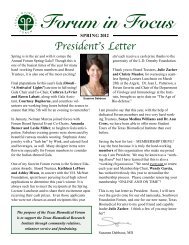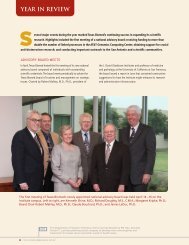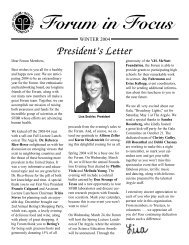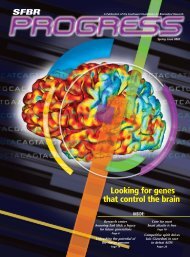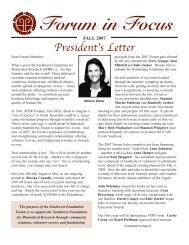Texas Biomed Science Report 2011-2012 - Texas Biomedical ...
Texas Biomed Science Report 2011-2012 - Texas Biomedical ...
Texas Biomed Science Report 2011-2012 - Texas Biomedical ...
Create successful ePaper yourself
Turn your PDF publications into a flip-book with our unique Google optimized e-Paper software.
18<br />
<strong>2011</strong>–<strong>2012</strong> Scientific <strong>Report</strong><br />
“The rapid advancement of next-generation DNA sequencing technology is providing a powerful tool to<br />
elucidate the genetic architecture of common complex disease. Using these technological advances,<br />
in combination with powerful computational resources, we aim to identify genes that<br />
contribute to preeclampsia susceptibility and several ocular disorders.”<br />
Matthew Johnson, Ph.D.<br />
Assistant Scientist, Genetics<br />
Preeclampsia is a common and serious complication of human<br />
pregnancy. Irrespective of gestation, delivery of the fetus and placenta<br />
is the only effective means to alleviate this condition. Furthermore,<br />
preeclampsia is known to increase a woman’s risk of later-life<br />
cardiovascular disease.<br />
Johnson has had an integral role in the objective identification of<br />
several promising preeclampsia candidate regions along chromosome 2q<br />
using both family- and population-based study designs. Additionally,<br />
he is specifically testing the hypothesis that four aminopeptidase genes<br />
residing on chromosome 5q contribute to a woman’s preeclampsia<br />
susceptibility profile. These four genes have known roles in blood<br />
pressure regulation, inflammation, immune response and pregnancy<br />
homeostasis, all of which are perturbed in preeclampsia.<br />
Age-related macular degeneration (AMD), glaucoma and diabetic<br />
retinopathy are several leading causes of blindness among American<br />
adults and all have significant genetic constituents. The identification<br />
of novel and the resolution of known genetic factors for these ocular<br />
disorders remains a major priority for the development and/or<br />
betterment of diagnostic tests prior to the onset of clinical symptoms.<br />
A new collaboration between the Casey Eye Institute in Portland,<br />
OR and <strong>Texas</strong> <strong>Biomed</strong> has resulted in a recently funded five-year<br />
NIH project to resolve known and identify novel AMD genetic<br />
susceptibility loci using a joint linkage/association methodology. This<br />
project will also reassess the AMD phenotype in a more quantitative<br />
manner and use next-generation sequencing technology to sequence<br />
Publications<br />
• Johnson MP, Roten LT, Dyer TD, East CE, Forsmo S, Blangero J, Brennecke SP, Austgulen R,<br />
Moses EK (2009) The ERAP2 gene is associated with preeclampsia in Australian and<br />
Norwegian populations. Hum Genet 126:655-66.<br />
• Fenstad MH, Johnson MP, Løset M, Mundal SB, Roten LT, Eide IP, Bjørge L, Johansson Å,<br />
Dyer TD, Forsmo S, Blangero J, Moses EK, Austgulen R (2010) STOX2 but not STOX1 is<br />
differentially expressed in preeclamptic decidua from Norwegian women. Mol Hum Reprod<br />
16:960-68.<br />
• Fenstad MH, Johnson MP, Roten LT, Aas PA, Klepper K, Vestrheim LC, East CE, Abraham LJ,<br />
Blangero J, Brennecke SP, Austgulen R, Moses EK (2010) Genetic and molecular functional<br />
characterization of variants within TNFSF13B, a positional candidate preeclampsia<br />
susceptibility gene on 13q. PLoS ONE 5(9) pii:e12993.<br />
• Løset M, Mundal SB, Johnson MP, Fenstad MH, Freed KA, Bjørge L, Blangero J, Moses EK,<br />
Austgulen R (<strong>2011</strong>) A transcriptional profile of the decidua in preeclampsia. Am J Obstet<br />
Gynecol 204:84.e1-84.e27.<br />
• Johansson ÅK, Curran JE, Johnson MP, Fenstad MH, Carless MA, Rainwater DL, Göring<br />
HHH, Austgulen R, Moses EK, Blangero J (<strong>2011</strong>) Identification of ACXO2 as a shared genetic<br />
risk factor for preeclampsia and cardiovascular disease. Eur J Hum Genet 19:796-800.<br />
• Lian IA, Løset M, Mundal SB, Fenstad MH, Johnson MP, Eide IP, Bjørge L, Freed KA, Moses<br />
EK, Austgulen R (<strong>2011</strong>). Increased endoplasmic reticulum stress in decidual tissue from<br />
pregnancies complicated by fetal growth restriction with and without pre-eclampsia.<br />
Placenta 32:823-29.<br />
the exomes of individuals from numerous AMD families.<br />
Johnson also is actively developing an ocular genetics research<br />
program in the San Antonio Family Heart Study (SAFHS) to identify<br />
and functionally characterize genes and genetic networks related to<br />
AMD, glaucoma and diabetic retinopathy among Mexican Americans.<br />
The SAFHS, initially conceived by <strong>Texas</strong> <strong>Biomed</strong> Scientists in<br />
1991, now includes more than 1,400 individuals from 42 extended<br />
Mexican American families from within the San Antonio area.<br />
E For more information, please visit www.txbiomed.org/departments/<br />
genetics/genetics-staff-bio?u=115




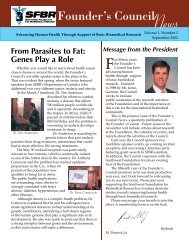
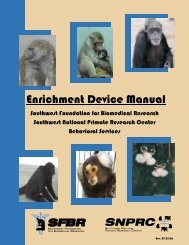
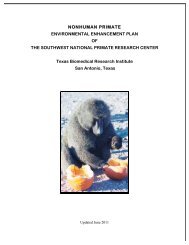
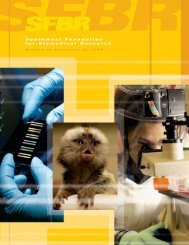
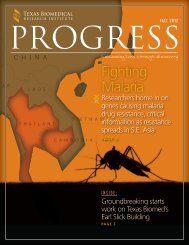
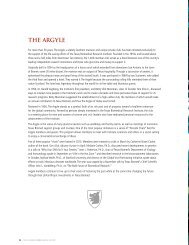
![Vol. 8 No. 2, 2011 [PDF] - Texas Biomedical Research Institute](https://img.yumpu.com/35688099/1/190x245/vol-8-no-2-2011-pdf-texas-biomedical-research-institute.jpg?quality=85)
